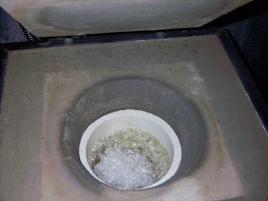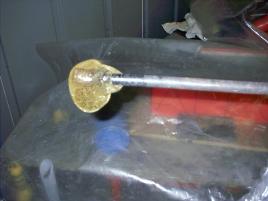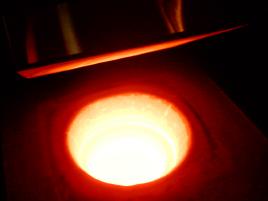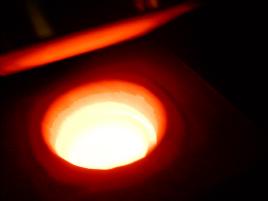.
Forth (current) Run: April 2, 2004 to July 14, 2005
Hours On: 10920 (455 days)
Charges: 38
Blow Sessions: 106
Session Time: 328 hours
Electricity Use: 8,574.0 kWh (Average = 566.1 kWh/month)
Electricity Cost: $844.01 (Average = $56.51/month)
Gas Use: 33.037 GJ (Average = 0.312 GJ/session)
Gas Cost: $273.27 (Average = $2,58/session)
Tin Shack Power requirements: 0.785 kWh/hr
Glass: Spruce Pine Batch
Comments: Power use figures include furnace, annnealer, lights and fans.
Third Run: February 2, 2004 to March 25, 2004
Hours On: 1008 (42 days)
Charges: 6
Blow Sessions: 9
Session Time: 43 hours
Glass: Spruce Pine Batch
Comments: Elements died at 1008 hours; not enough stretch.
Second Run: January 10, 2004 to January 21, 2004
Hours On: 420 (17.5 days) (First Run hours included)
Charges: 1
Blow Sessions: 2
Session Time: 7 hours
Glass: Spruce Pine Batch
Comments: Elements died at 420 hours (same elements as First Run).
First Run: November 21, 2003 to Movember 27, 2003
Hours On: 158 (6.5 days)
Charges: 1
Blow Sessions: 1
Session Time: 2 hours
Glass: Cullet made from Spruce Pine Batch
Comments: Glass overflowed at 2400F and damaged furnace.
Replaced the existing glory hole burner head (Gibberson 650) with a Gibbeau burner head. The new burner tip has a much shorter flame length (8" vs. 20") and heats the glory hole much quicker. Photos can be found under the maintenance link.
Here are a couple of pictures of my charging supplies, including my current aluminum scoop, my Gott charging glove and coolsleeve, a leather glove (for opening the furnace when it's at charging temp), and a nice bag of Spruce Pine batch.
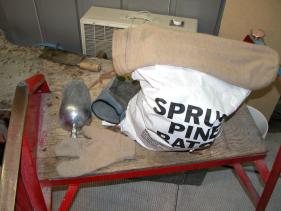
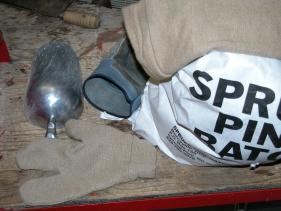
Replaced the Watlow controller on the furnace with the second new Fuji controller. To be careful, I replaced the controller after my blowing session but before I started charging. That way, I had some time while the furnace cooled from 2070 to 1850 to get everything working. As it was, I had plenty of time.
The new controller took some time to self-tune, giving me a small scare. After turning the furnace back on, the temperature dropped to around 1825 before the controller really "kicked in" to bring it back to 1850.
The ramp/soak feature is sweet. I have two programs on this controller, one for blowing and one for charging.
Replaced the malfunctioning Watlow controller on the annealer with the first new Fuji controller. Tested it out, and everything works perfectly. The Fuji holds the setpoint temperature exactly, unlike the Watlow's which had a variance (i.e. the annealer always ran 5 degrees F lower than the setpoint, while the furnace ran 10 degrees F lower). The Fuji is self-tuning, so you could see the controller slowly "dial in" the right settings after a day's use.
The ramp/soak is a great feature. I just program the controller for a day's blowing, and don't have to worry about anything - it's all automatic.
The Watlow controller died on me today. The controller was up to it's usual tricks (at least since since March 6) with the display, but I still I had a good blowing session.
After the session I set the furnace to cool from 2060F (blowing temp) to 1850F (holding temp). I also left the annealer at 920F for one hour to "soak". When I returned to start the annealer ramping (920F to 50F at 100F/hr), I noticed the furnace controller was just "blank", and the SSR's were not firing. This was at 5pm.
Light taps on the controller didn't help, so I power-cycled the furnace a few times. Still nothing. I grabbed a screwdriver and removed the controller from the housing, and just let it dangle. This time, when I applied power to the furnace, it came back on and stayed on. The temperature was just above 1700F, so at least I wasn't "too late". I ramped the furnace back up to 1850, and tied the controller in place with some string. I decided to check it frequently for a while. By 9pm the controller was still working OK, and besides - I wasn't going to stay there all night.
The next morning the annealer was at 50F, and the furnace was still on. I decided to swap controllers between the annealer and the furnace, as the annealer controller was working fine and the annealer wasn't required 24/7 like the furnace. The changeover went without incident, and the furnace is again holding 1850F without any problems.
Time to order that Fuji Controller...
I contacted the local Watlow dealer. Althought the controller is under warranty, it must be sent to Toronto for repair, and I don't have a spare controller at this time.
A replacement Watlow is $248 CDN (no programs, no communications). One with programming is almost $350 CDN. Before I drop that kind of money on a new controller, I think I'll have a look around at what else is available.
As it turns out, it didn't take long. Talking with Mark Lauckner as well as my friends on Craftweb, there are several brands available. Checking up on the various controllers on the Internet, it appears the sweetest deal is a Fuji controller that's pretty much a direct replacement for the Watlow - except it's $129 US and is programmable. For $40US more, I can get RS485 communications as well, allowing me to control the Tin Shack's furnace (and annealer if I buy two) from inside the house via computer. Sweet!!!
The Watlow controller on the furnace started giving trouble today during my blowing session.
The controller's main display consists of 4 8-segment LEDs. The fourth digit varies between showing nothing and showing and extra-bright '8'. Touching the controller can switch the display between the two extremes. It sure looks like a "cold solder" joint to me. At this time, the problem does not seem to affect the function of the controller, just the display. For now I will just monitor it.
The furnace passed 6 months continuous duty yesterday (4371 hours).
The last element change was on April 2, 2004 to 11 Ga Kanthal A-1, but stretched to 3-1. That night I started up the furnace. It was shut down for a 2-week period in May when I was diving at the coast and visiting Mayne Island. Then it was turned back on and remains on.
Resting temp is 1850F, blowing temp 2070F, charging temp 2100F, cooking temp 2250F. Most of the time the furnace is at 1850. The entire run of this furnace has been with Spruce Pine (initially some cullet, then batch).
Energy use since Feb 2, 2004: Gas $175, Electricity $600. Not bad for the Tin Shack!
Begin heating to temperature at 8pm on April 2. Ramp at 25F/hr due to 2/3 full crucible.
Charging cycle begins April 5. I am trying out shorter cook time.
The pictures are from the April 5 charge, and show the crucible 1 and 2 hours after the last batch addition, and again before and after the cooking process. The gather was taken just before the squeeze. There are 3 pictures because I was playing with lighting and flash effects.
The final two pictures are of the furnace glass under natural light conditions (i.e. from the heat alone).
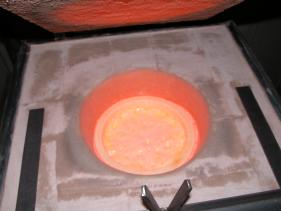
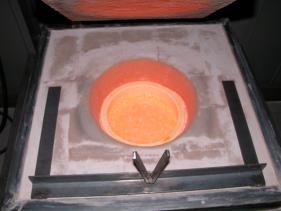
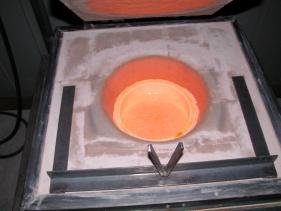
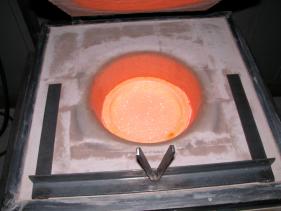
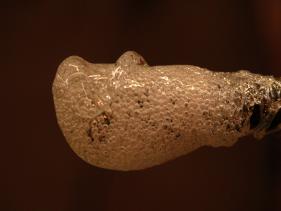
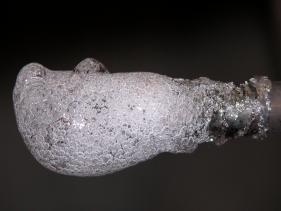
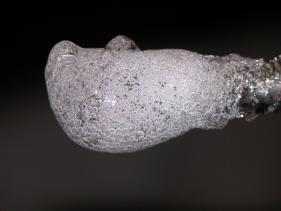
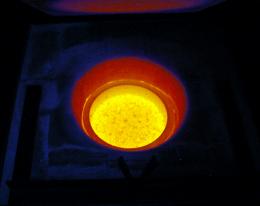
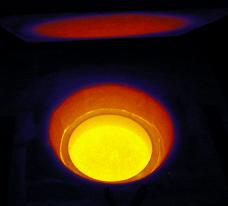
March 25 - April 2, 2004 - Furnace Maintenance (element change and lid rebuild)
March 21, 2004 - Element failure during charge - 1008 hours 'on'. February 8 - March 21, 2004 - 5 charges, 1 'blowdown', 8 glassblowing sessions
February 2 & 10, 2004 - Equipment changes
January 23, 2004 - Furnace Maintenance (element change)
January 20 2004 - Element failure during charge - 420 hours 'on'
January 10 - 20 2004 - 1 charge, 1 'blowdown', 1 glassblowing session
I have finished charging with Spruce Pine batch at 2150, and the cooking process at 2250 is also complete.
I finished charging at 7:30 pm on January 12, and increased the temperature to 2250F. Although the furnace reached that temperature in an hour, the mass of glass (40 lbs) took considerably longer to reach equilibrium. It was 12:30 am (just after midnight) before the temperature was stable at 2250F. During that time, the glass expanded (due to heating) in the crucible.
When I started cooking, the glass was at 2150F and sitting just over 1 inch from the lip of the crucible. As the glass heated, it started expanding. At 9:30, it was 3/4 inch below the lip, and 1/2 inch at 10:00 pm. At that time, I used a punty to gather up some of the surface bubbles and lower the glass level to 1 inch again. I repeated this process at 11:00 pm and again at midnight. By midnight, the glass expansion had virtually stopped, and by 12:30 equilibrium was attained. This was also reflected in the temperature recovery temperatures and times. At 9:30, opening the furnace for 10 seconds to peek lowered the temperature from 2250 to 2234, and it took 10 minutes to recover. At midnight, the same action only lowered the temperature to 2248, and it recovered within 30 seconds.
The glass cooked at 2250F from midnight until noon, January 13. At noon, the bubbles were almost gone from the surface of the glass, but the glass was very seedy (as expected). I took two gathers to examine the glass. It was excellent to gather, and the bubbles were uniform and "pinhead" sized. The glass was cooked! Time to squeeze.
I chose to do a "hard squeeze". The furnace has controller options to change temperature (up and down) using a ramp function (where the rate is adjustable), or no ramp. I set the furnace to 1920F with the ramp turned off, to cool the glass quickly.
The pictures here show the furnace just after the cooking is done, but before the squeeze. Also shown are pictures of the two gathers I took. The first gather was quenched in ice water, but the second has just been exposed to air.
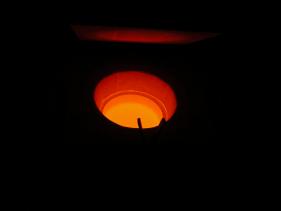
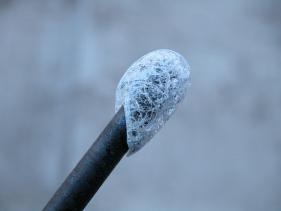
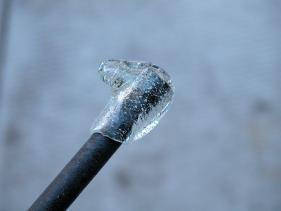
The furnace rebuild is complete, and I have started charging with Spruce Pine batch.
I tried to install a gathering port stop on January 11, but it proved difficult and must be re-designed. A crude but effective lid switch was installed, consisting of a microswitch mounted on a bar clamped to the controller upright. In two days of testing (so far) it works perfectly.
I started heating the furnace and empty crucible on January 10, heating from 75F to first 900F, then 1000F, 1100F and finally 1850F using a ramp of 100F per hour. At 900, 1000 and 1100 I held the temperature for 2 hours (each level) in order to pass the quartz inversion.
I started charging on January 11. First, I ramped the furnace and empty crucible up to 2150F (100F/hr) and then started charging. Charging began just after noon. Each charge I added batch to fill about 25% of the crucible volume. Then, I waited approximately 2 hours for the batch to melt down flat before adding more.
As of 2:30 pm January 12, I had the crucible almost full of melted glass. I added one final charge and will then heat the glass to 2250F to cook this evening and overnight.
The pictures show the Tin Shack in January (thank goodness for Calgary Chinooks!!!), the finished furnace, the new lid switch, my cool batch scoop, and melting the batch (at 2150F) before and after a final charge has been added. I apologise for the focus in the first 'melting the batch' picture - the camera didn't want to focus, and the heat was such that I wasn't going to stay and argue (hard on the camera)!
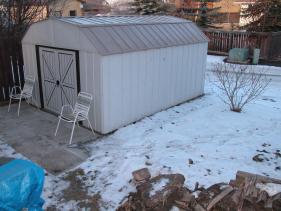
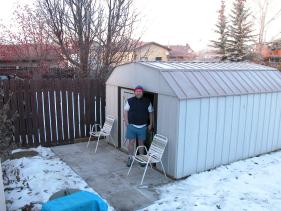
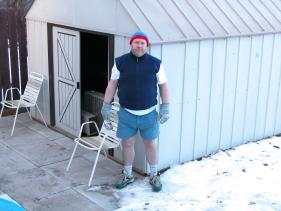
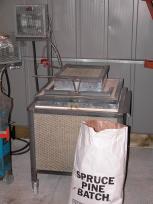

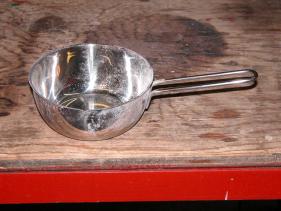
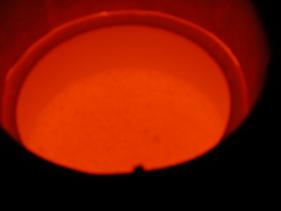
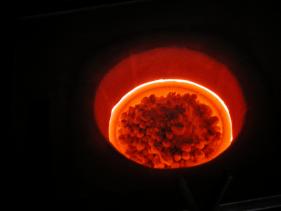
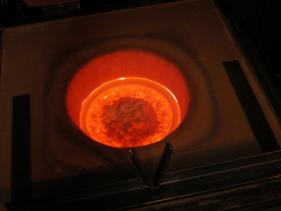
January 8 2004 - The furnace rebuild is almost complete.
January 5 2004 - The furnace rebuild is progressing nicely.
January 2 2004 - The furnace rebuild has begun.
November 30, 2003 - The furnance is now cold, and the analysis has begun.
November 28, 2003 - I've been cooling the furnace at 100F per hour.
The furnace has been damaged by foaming glass during the first charge with cullet. The glass temperature did not seem to come up as indicated on the controller display, indicating some problem with the thermocouple or it's placement. At 2250F, the glass was stiff and "dented" by a puntie. I heated it to 2400F (on the controller). After 2 hours, no real change. After 5 hours - foam had bubbled up and destroyed the alumina board surrounding the crucible. The furnace must be emptied, cooled, inspected and repaired.
Here are pictures of the cullet in a pillowcase being dried in the annealer, then photos of the glass melting (at 1250F), and then the disaster at 2400F (after the alumina board was eaten away - you can barely make it out due to the glow).

